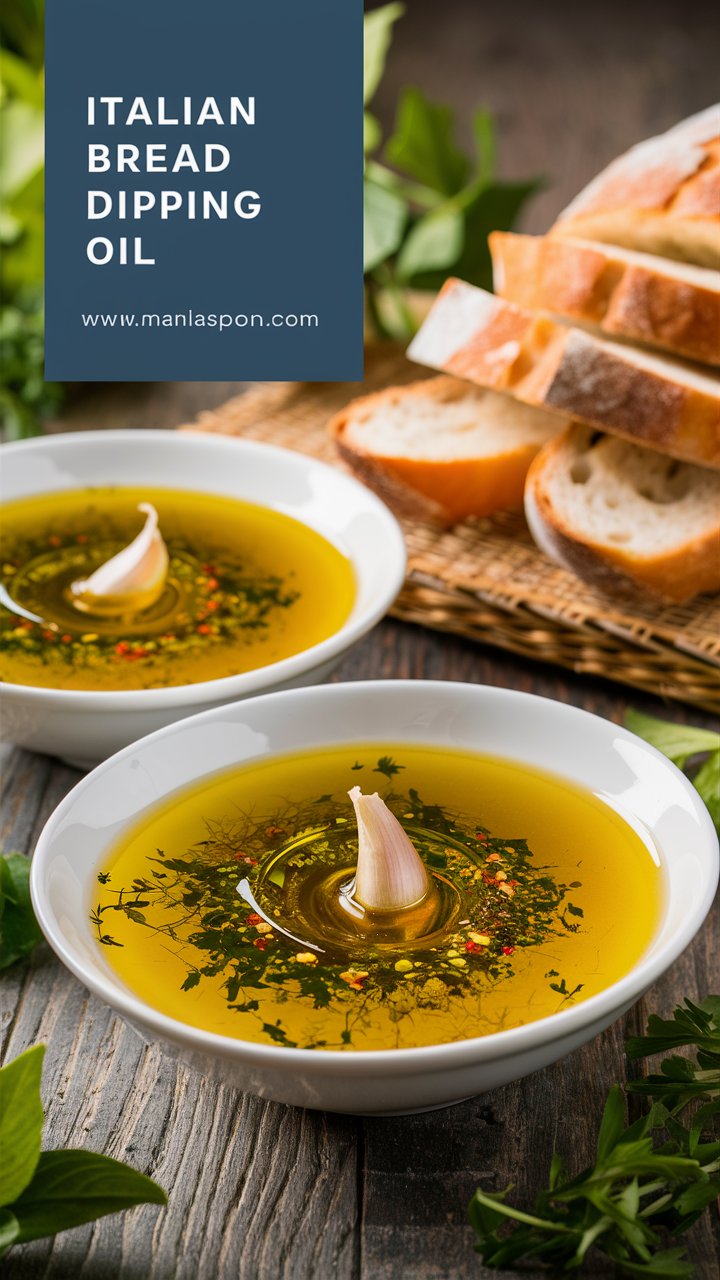
5-Minute Italian Dipping Oil with Fresh Herbs & Parmesan 2025
Few things are more satisfying than tearing into a warm piece of crusty bread and dipping it into a fragrant, flavorful oil. Italian dipping oil with balsamic elevates a simple loaf into a gourmet experience, perfect for family dinners, dinner parties, or solo indulgence. This recipe is elegant yet simple, requiring minimal ingredients and preparation time. In this complete guide, we’ll explore every aspect of this delightful appetizer—from ingredients and step-by-step instructions to creative variations, serving suggestions, and tips for perfect flavor every time.
Why You’ll Fall in Love with This Recipe
This Italian dipping oil is more than just a side—it’s an experience. Here’s why it stands out:
- Quick and easy: Ready in just 5–10 minutes.
- Restaurant-quality flavor: Bold, herby, and tangy, reminiscent of authentic Italian cuisine.
- Customizable: Adjust herbs, spice, and cheese to suit your taste.
- Versatile: Perfect with bread, salads, charcuterie, or roasted vegetables.
- Elegant presentation: Simple to plate yet visually appealing, ideal for entertaining.
Ingredients You’ll Need
The quality of your ingredients defines the flavor of your dipping oil. Here’s what you’ll need:
Olive Oil
- Cold-pressed extra virgin olive oil is the base of this recipe. Its rich, smooth texture and heart-healthy fats make it ideal. Avoid generic or low-quality oils, as they can taste bitter or flat.
Herbs
- Fresh basil and Italian seasoning add depth and a Mediterranean flair. Fresh herbs are preferred, but dried herbs can be used if needed (reduce quantity slightly).
- Optional additions: rosemary, thyme, oregano.
Spices
- Crushed red pepper flakes provide a gentle heat that balances the richness of the oil.
- Salt and freshly ground black pepper enhance all flavors naturally.
Garlic
- Minced garlic infuses the oil with aromatic depth. Roasted garlic can be used for a sweeter, mellower flavor.
Cheese
- Parmesan adds salty, nutty complexity. Grate just before serving for maximum freshness. Alternatives include Pecorino Romano or Asiago.
Balsamic Vinegar
- Aged balsamic vinegar provides a sweet-tangy finish that elevates the dipping oil. Drizzle just before serving to maintain flavor integrity.
Optional Additions
- Lemon zest for brightness
- Sun-dried tomatoes for depth
- Ricotta for a creamy variation
Step-by-Step Guide to Making Italian Dipping Oil
Step 1: Select Your Olive Oil
Start with a small bowl or shallow dish. Pour in cold-pressed extra virgin olive oil as the base. Using a shallow dish allows herbs and cheese to spread evenly and creates an inviting presentation.
Step 2: Prepare Herbs and Garlic
Chop fresh basil finely and mince garlic. Measure Italian seasoning and crushed red pepper flakes. These ingredients are the flavor foundation.
Step 3: Combine Ingredients
Stir the herbs, garlic, spices, salt, pepper, and freshly grated parmesan into the olive oil. Mix gently to combine without bruising the herbs. Let the mixture sit for a few minutes to allow flavors to meld.
Step 4: Drizzle Balsamic Vinegar
Right before serving, drizzle aged balsamic vinegar over the mixture. This final step preserves the vinegar’s bright, tangy flavor and prevents it from overpowering the herbs and oil.
Step 5: Serve with Bread
Pair with freshly baked baguette, ciabatta, or focaccia. Warm the bread slightly for contrast if desired. Arrange the oil in a visually appealing dish to make it look as good as it tastes.
Pro Tips for Maximum Flavor
- Fresh vs. dried herbs: Fresh herbs provide vibrant flavor, but dried herbs can be used in a pinch. Reduce the amount slightly and allow to bloom in the oil for a few minutes.
- Cheese: Grate parmesan just before serving to prevent clumping and maintain texture.
- Serving temperature: Room temperature is ideal. Olive oil solidifies in the fridge; let it return to room temperature before serving.
- Bread pairing: Rustic bread varieties complement this oil best. Avoid overly soft or sweet bread that may clash with the herbaceous flavors.
Creative Variations and Substitutions
- Herb swaps: Add rosemary, thyme, or oregano for new flavor profiles.
- Cheese alternatives: Pecorino Romano or Asiago can replace parmesan for a sharper taste.
- Citrus touch: Lemon zest adds a bright, refreshing note.
- Sun-dried tomatoes or roasted garlic: Deepen the flavor for a more complex profile.
- Creamy variation: Stir in a spoonful of ricotta to create a richer, silkier dip.
Pairing Ideas: What to Serve With
Italian dipping oil is incredibly versatile. Some ideal pairings include:
- Bread: Freshly baked baguette, focaccia, or ciabatta
- Appetizers: Antipasto platters, marinated olives, or grilled vegetables
- Charcuterie boards: Prosciutto, salami, and aged cheeses
- Salads: Caprese salad or simple green salads enhance the Mediterranean vibe
- Vegetables: Roasted bell peppers, zucchini, or eggplant for dipping
Storage, Leftovers, and Make-Ahead Tips
- Short-term storage: Keep leftover oil mixture in an airtight container for up to 2 days without balsamic vinegar.
- Refrigeration: Olive oil may solidify in the fridge. Allow it to return to room temperature before serving.
- Freezing: Not recommended due to texture changes with fresh herbs and cheese.
- Make-ahead: Mix the oil, herbs, and spices ahead of time, but add balsamic just before serving to maintain flavor and presentation.
Frequently Asked Questions (FAQs)
Can I use dried herbs instead of fresh?
Yes, but reduce the quantity slightly. Let the dried herbs sit in the oil for a few minutes to release their flavor fully.
Will the cheese make the oil gritty?
Freshly grated parmesan blends smoothly and enhances the oil without gritty texture. Avoid pre-grated cheese that contains anti-caking agents.
Is this recipe keto-friendly?
Absolutely! Pair with keto-friendly bread or crackers for a low-carb option.
How can I make it spicier?
Increase crushed red pepper flakes or add a pinch of cayenne for a fiery kick.
What type of balsamic is best?
Aged balsamic vinegar adds depth, sweetness, and a syrupy texture that balances the richness of olive oil.
Can I serve it warm?
The oil itself is meant for room temperature, but slightly warming the bread enhances the dipping experience.
The Health Benefits of Italian Dipping Oil
- Olive oil: Rich in monounsaturated fats, it supports heart health and reduces inflammation.
- Herbs: Basil, oregano, and thyme provide antioxidants and vitamins.
- Garlic: Known for its immune-boosting properties and cardiovascular support.
- Cheese moderation: Parmesan adds flavor without excessive calories if used sparingly.
Why This Recipe Works Every Time
The success of this Italian dipping oil lies in simplicity, balance, and quality ingredients. Each component—from fresh herbs to aged balsamic—plays a specific role, creating a harmonious and sophisticated flavor. The recipe is forgiving, making it suitable for both beginners and seasoned cooks.
Perfect for Every Occasion
This versatile recipe fits nearly any setting:
- Casual family meals: Elevates a simple dinner.
- Dinner parties: Elegant appetizer without stress.
- Romantic date nights: Pairs beautifully with wine and fresh bread.
- Last-minute hosting: Quick to assemble, impressive to serve.
Tips for Making it Instagram & Pinterest-Worthy
- Plating: Use shallow, wide dishes to display herbs and oil evenly.
- Garnishing: Sprinkle extra parmesan or drizzle balsamic in a swirl pattern.
- Photography tips: Use natural light and rustic backgrounds; capture a bread-dipping moment for engagement.
Common Mistakes to Avoid
- Using low-quality olive oil
- Overpowering the oil with too much garlic or herbs
- Adding balsamic too early
- Serving with cold or overly soft bread
- Skipping freshly grated cheese
Conclusion & Final Thoughts
Italian Dipping Oil with Balsamic is more than just an appetizer—it’s an invitation to savor simple, bold, and balanced flavors. Whether you’re entertaining guests, enjoying a cozy meal, or looking for a last-minute indulgence, this recipe delivers every time. With its flexibility, elegance, and minimal effort, it’s a kitchen staple worth mastering. Try it with different breads, experiment with variations, and make it your own. One dip, and you’ll be hooked.


